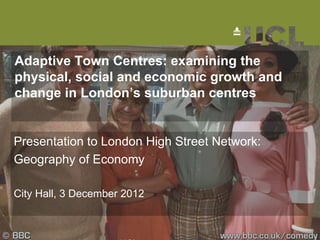Adaptive Town Centres: examining the physical, social and economic growth and change in LondonŌĆÖs suburban centres
- 1. Adaptive Town Centres: examining the physical, social and economic growth and change in LondonŌĆÖs suburban centres Presentation to London High Street Network: Geography of Economy City Hall, 3 December 2012
- 2. INTRODUCTION AND OUTLINE ŌĆó LondonŌĆÖs suburban evolution ŌĆó LondonŌĆÖs commercial ecology ŌĆó The importance of diversity of scale and use
- 3. Town centres in policy The boundaries of the town centre have become fixed in policy makers minds, even though much activity falls outside of the boundary.
- 4. Town centres in policy Land use is more extensive and varied than national statistics would suggest.
- 5. Not just retail, offices A significant amount of non-retail and office activity takes place in smaller town centres Barnet 2008 Much of this is comprised of local businesses, as well as regional and national chains Surbiton 2008
- 6. Shopping as by-product of other activities The majority of town centre inhabitants and visitors donŌĆÖt shop. Those that do, have a wide variety of other activities. What else do shoppers+ do? Business meeting Catching a train/bus/tube Coffee/tea/drink Do nothing/ hanging out Doctors/hospital/dentist Eat Univariate Bar Chart Get money Split By: activity Row exclusion: shoppers.svd Go for a w alk Gym/leisure centre/sports 25 Library 11 Live here 10 Meet family/friends 8 On school lunch break total count 6 Park/allotments/recreation ground 5 Passing through 4 Pay bills 3 Post a letter 2 Post office 1 Pub/bar Observations School/college/university Take children to/from nursery/playschool Take children to/from school Visit family/friends Wait for family/friends Walk the dog Window shop Where do shoppers+ go? Work here
- 8. Understanding London as a network of emergent linked centres, rather than a planned hierarchy AbercrombieŌĆÖs plan of London, 1944
- 9. Image shows measure of Choice 800m, which predicts flows of movement within a reach of 800 metres along each street segment within the network. The warmer the colour, the higher the predicted flow. All existing buildings are coloured black. Loughton c. 1880
- 10. Loughton c. 1890 Image shows measure of Choice 800m, which predicts flows of movement within a reach of 800 metres along each street segment within the network. The warmer the colour, the higher the predicted flow. All existing buildings are coloured black. Loughton c. 1915
- 11. Loughton c. 1915 Image shows measure of Choice 800m, which predicts flows of movement within a reach of 800 metres along each street segment within the network. The warmer the colour, the higher the predicted flow. All existing buildings are coloured black. Loughton c. 1965
- 12. Loughton c. 1965 Image shows measure of Choice 800m, which predicts flows of movement within a reach of 800 metres along each street segment within the network. The warmer the colour, the higher the predicted flow. All existing buildings are coloured black. Loughton c. 2012
- 14. 113 outer London town centres ordered by commercial floorspace Long tail of activity 900000 Croydon 800000 (2008 data) 700000 600000 500000 Flr_Space_Sqm Approx. top 15 centres 400000 Watford account for 50% of 300000 Uxbridge commercial floorspace; 200000 approx. 100 account for 100000 0 the other 50% -100000 Observations Smaller centres contribute to sustainable 113 outer London town centres ordered by commercial floorspace (excluding Croydon, Kingston, Watford, Bromley and Ealing) 300000 Romford urban life by supporting 250000 socio-economic and Uxbridge 200000 cultural diversity across Flr_Space_Sqm 150000 a wide range of activities Brent Cross and nurturing them at 100000 Surbiton Chipping the local scale. Essential 50000 Barnet South Norwood links in the chain 0 -50000 Observations
- 15. Adaptability inherent in diversity of network over time Businesses in Surbiton over time Percentage of all businesses within the time period 45 40 35 30 % Community Services % Industrial Services 25 % Offices & Commerce % Retail. 20 % Businesses with Manufacture 15 % Food/drink/accommodation 10 5 0 1876 1915 1965 2012
- 16. LAND-USE AND CHOICE Small-scale spatial model reveals long-tail of activity, longevity of non-residential presence in the area Choice radius 400
- 17. LAND-USE AND CHOICE Distribution of uses varies across location and scale of potential journey. Choice radius 800
- 18. LAND-USE AND CHOICE A given street or area may be central at a local scale but relatively segregated at a larger scale. Choice radius 1600
- 19. CONCLUSION: THE NEED FOR DIVERSITY
- 20. c.1915 c.1875 Built Form change and adaptation and path dependency: from stables to trams to the motor car
- 21. Suburban adaptability - sustainability ŌĆó Future of centres is same as past: not to rely on retail alone but to encourage greater mixing within the block or even unit ŌĆó Smaller centres have the potential to provide a more targeted, genuinely sustainable growth, because of their scale and urban form: enabling local/non-local transactions alongside each other ŌĆó Adaptability of the built environment relates to the ability of network to carry different movement scales ŌĆó Consider ŌĆśaffordable businessesŌĆÖ as much as ŌĆśaffordable housingŌĆÖ ŌĆó Importance of diversity in business classes ŌĆō a return, or a new form, of Backyard workshops in high street hinterland. Allows for diversity of users and activities small-scale manufacture?
- 22. Mixed use taken to its extreme conclusion
- 23. Mixed use within a single business; production returning to the suburbs
- 24. Adaptable Suburbs Project www.ucl.ac.uk/adaptablesuburbs @AdaptableSuburb Victor Buchli Ruthie Carlisle Ashley Dhanani Claire Ellul Sam Griffiths Muki Haklay David Jeevendrampillai Patrick Rickles Laura Vaughan
























